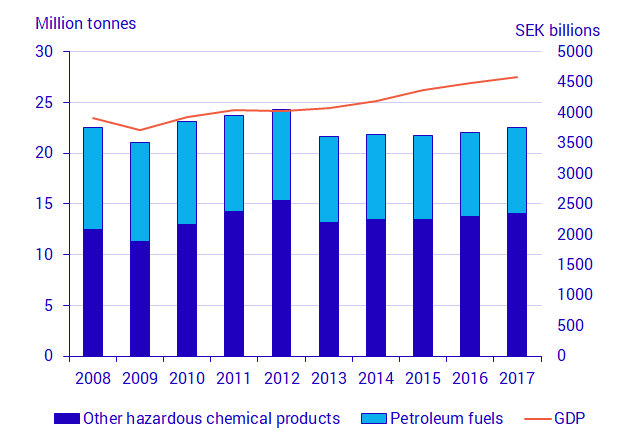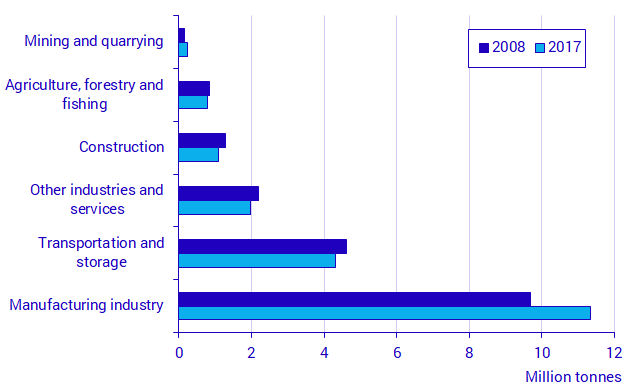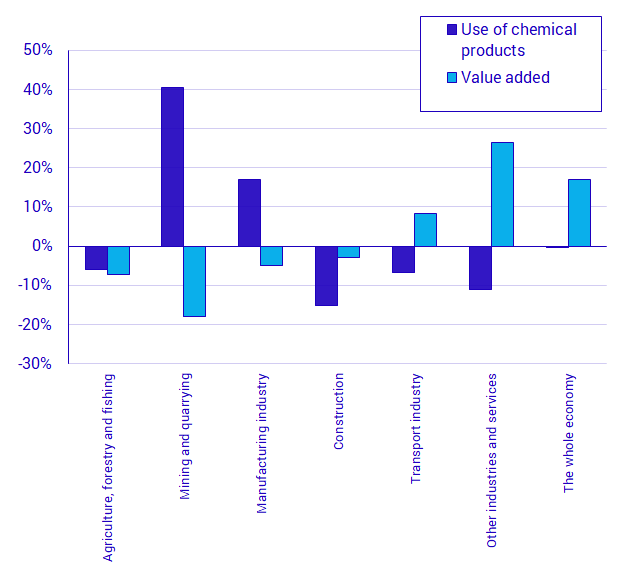Environmental accounts – Chemical indicators 2017
Share of chemical use in production fell between 2008 and 2017
Statistical news from Statistics Sweden 2019-05-29 9.30
In Sweden, chemical intensity, that is, the level of chemicals in tonnes used per Swedish krona produced, fell by 15 percent between 2008 and 2017. This is due to the fact that the Swedish economy has grown during this period, while the use of chemicals has remained relatively unchanged.
In Sweden, chemical intensity, that is, the level of chemicals in tonnes used per Swedish krona produced, fell by 15 percent between 2008 and 2017. This is due to the fact that the Swedish economy has grown during this period, while the use of chemicals has remained relatively unchanged.
Petroleum fuels used less than before
In 2017, the business sector in Sweden used 22.5 million tonnes of chemicals that are classified as hazardous to health and the environment. This is approximately the same level as in 2008. Petroleum fuels, which are hazardous both for health and the environment, account for just over one third of the chemical turnover. The use of petroleum fuels in the period 2008–2017 has decreased, while other health and environmentally hazardous chemicals showed an increasing trend.
However, it is important to note that changes over time need not only be due to actual volume changes. The chemicals that are classified as hazardous to health and the environment may also have changed.

Source: Statistics Sweden, Environmental accounts and national accounts, and the Swedish Chemicals Agency. Note: Petroleum fuel is hazardous to both health and environmentally, but is shown here as a separate group.
Chemical use increasing in the manufacturing sector
The manufacturing sector is the industry group with the largest use of chemicals (11.3 million tonnes). Since 2008, this sector has also had the largest increase in absolute terms (1.6 million tonnes). In the manufacturing sector, the chemical and pharmaceutical industry and manufacturers of non-metallic mineral products used the most chemicals in their production. In 2017, these industries used 7.5 million tonnes of chemicals. They also accounted for a large share of the increase in the use of chemicals in the manufacturing sector between 2008 and 2017.
The transport sector also accounted for a large share of the use of chemicals (4.3 million tonnes) due to its extensive use of petroleum fuels, despite decreased use of such fuels (0.3 million tonnes) between 2008 and 2017.

Source: Statistics Sweden and the Swedish Chemical Agency
In addition to the manufacturing sector, the use of chemicals has increased in mining and quarrying, while the use has decreased in other industries.
For the Swedish economy as a whole, GDP increased by 17 percent, while the share of the use of chemicals in the Swedish economy as a whole has remained unchanged. This means that chemical intensity in the Swedish economy has decreased, that is, fewer chemicals are used per produced Swedish krona in GDP.

Source: Statistics Sweden, Environmental accounts and national accounts, and the Swedish Chemicals Agency.
Revisions
Miscalculations on the use of petroleum fuels in other industries and service sectors have been corrected. This resulted in a downwards revision of the use of petroleum fuels by 27 percent on total petroleum use between 2008 and 2016 compared with the previous year’s publication.
Definitions and explanations
The Swedish Chemicals Agency is responsible for the Products Register, in which chemical products are registered and for which there are time series available from 1992. The primary purpose of the register is to monitor chemical handling, import and production, downstream use and labelling of chemicals for regulatory purposes, statistics and follow-up. The register contains information about the chemical products and the quantities used.
The indicators published by Statistics Sweden measure the quantity of products that are classified as hazardous to health and the environment under international criteria, broken down by industry.
This classification is based on Council Directive 67/548/EEC, which has been extended and amended many times. EC Regulation (EC) No 1272/2008 introduced major changes and a new classification, the Globally Harmonised System of Classification and Labelling of Chemicals (GHS).
In these statistics, hazardous chemical products refer to products that are classified as Very toxic (T+), Toxic (T), Corrosive (C), Irritant (Xi), and Harmful (Xn) according to KIFS 2005:7. From 2009, in accordance with Regulation (EC) No 1272/2008, products are classified as Corrosive (GHS05), Toxic (GHS06), Harmful (GHS07), and Health hazard (GHS08). Environmentally hazardous chemicals refer to products classified as Environmental hazard (N before 2009, and GHS09 after 2009).
Next publishing will be
The next statistical news in this series is scheduled for publishing in 2020.
Feel free to use the facts from this statistical news but remember to state Source: Statistics Sweden.
